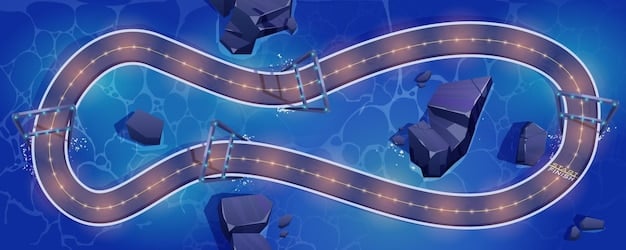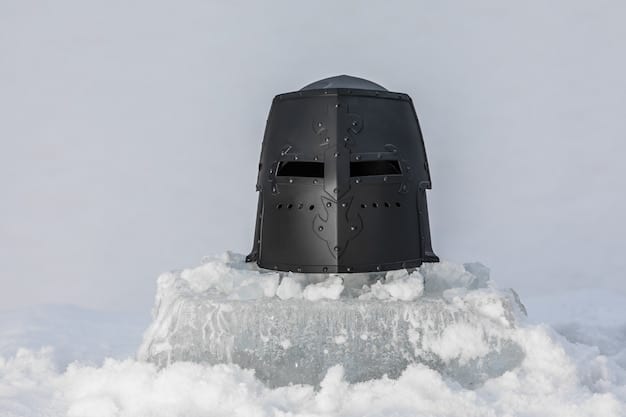Master Wave Management in LoL 2025: Dominate Lanes & Objectives

Wave management in League of Legends is crucial for creating opportunities for ganks, roams, and objective control, allowing players to dictate the pace of the game and secure advantages over their opponents by manipulating minion waves.
Understanding and executing effective wave management is paramount for success in League of Legends 2025. Controlling minion waves allows you to dictate the flow of the game, creating opportunities for ganks, roams, and securing objectives, ultimately leading to victory.
Understanding the Basics of Wave Management
Wave management is a fundamental skill in League of Legends, referring to the art of manipulating minion waves to achieve a specific strategic advantage. It involves understanding how minions interact, how to influence their movement, and how to use this knowledge to control the lane state.
Effective wave management allows you to set up favorable situations, such as freezing the lane near your tower to deny your opponent farm, pushing the wave to create pressure on the enemy tower, or setting up a slow push to draw the enemy jungler’s attention. Mastering these techniques can significantly impact your laning phase and overall game strategy.
Minion Aggro and Wave Equilibrium
Minions will prioritize attacking enemy champions who attack allied champions. Understanding minion aggro is key to controlling the wave. Additionally, wave equilibrium refers to the natural balance point of the minion waves, where they meet in the middle of the lane.
Different Wave States
- Slow Push: Accumulating a large wave to crash into the enemy tower.
- Fast Push: Quickly clearing a wave to roam or pressure objectives.
- Freeze: Holding the wave near your tower to deny the enemy farm and experience.
- Neutral Wave: Allowing the waves to meet in the middle of the lane without interference.
By understanding these wave states and how to achieve them, you can effectively control the lane and create opportunities for yourself and your team. Manipulating minion waves requires practice, but mastering these techniques will elevate your gameplay significantly.
Setting Up Ganks Through Wave Control
One of the most significant advantages of effective wave management is the ability to set up ganks for your jungler. By controlling the wave, you can create situations where the enemy laner is overextended and vulnerable to a gank.
Freezing the wave near your tower is a classic technique for setting up ganks. When the enemy laner pushes forward to farm, they become an easy target for your jungler, who can then capitalize on the opportunity and secure a kill.

Freezing the Lane for Gank Opportunities
When you freeze the lane, you are intentionally keeping the minion wave just outside of your tower range. This forces the enemy laner to overextend if they want to farm, making them vulnerable to a visit from your jungler. Effective freezing requires precise control and awareness of minion health.
Slow Pushing to Draw Jungler Attention
Alternatively, you can set up a slow push to draw the enemy jungler’s attention to your lane. As the wave grows larger, the enemy laner will be forced to deal with it, potentially attracting the enemy jungler to defend their tower. This can relieve pressure on other lanes and potentially set up counter-ganks.
By effectively managing your waves, you can dictate the enemy jungler’s movements, providing valuable information to your team and creating opportunities for your allies to make plays elsewhere on the map. This strategic control over the lane phase can lead to significant advantages in the mid and late game.
Facilitating Roams with Proper Wave Management
Wave management isn’t just about setting up ganks; it’s also about creating opportunities for yourself to roam to other lanes. By strategically pushing or freezing the wave, you can free yourself up to assist your teammates without sacrificing too much farm or experience.
Pushing the wave to the enemy tower allows you to create a window of opportunity to roam. With the wave crashing into the tower, the enemy laner will be preoccupied with defending, giving you time to move to another lane and make a play.
Creating Roaming Windows
Before roaming, ensure that your wave is in a favorable position. Pushing the wave to the enemy tower before you leave will deny the enemy laner farm and experience while you are gone. Also, consider the timing of your roams to ensure they are impactful. Roaming at key objective timings, such as before a dragon fight, can significantly increase your team’s chances of success.
Minimizing Losses While Roaming
While roaming, keep an eye on the state of your lane. If the enemy laner is pushing back, consider returning to your lane to catch the wave and prevent them from taking your tower. Effective roaming requires a balance between assisting your teammates and maintaining your own lane presence.
- Communicate your intentions with your team.
- Ward your lane to prevent getting ganked.
- Consider bringing sweeper to deny vision for enemies.
By mastering wave management, you can effectively balance your laning responsibilities with your team’s needs, making you a more valuable asset to your team. Remember that wave management is not static, but dependent on the dynamic of the match and enemy movements.
Strategic Use of Wave Management for Objective Control
Wave management plays a crucial role in securing objectives such as dragons, Rift Herald, and Baron Nashor. By strategically controlling the minion waves around these objectives, you can create pressure on the enemy team and influence their decision-making.
Prior to an objective fight, pushing the wave into the enemy towers in side lanes can force the enemy team to split their attention, giving your team an advantage around the objective. This can also create opportunities for your team to take towers while the enemy team is preoccupied with the objective.

Creating Pressure Before Objective Fights
Pushing the side lanes creates pressure on the enemy team, forcing them to respond to the threat of losing towers. This can pull defenders from the objective fight, creating a numbers advantage for your team. Effective wave management before objective fights can significantly improve your chances of securing the objective.
Securing Tower Advantage
By pushing the waves, you can often force the enemy to make a choice between contesting the tower and contesting the objective. If the enemy leaves the lane to defend the objective, you can take the tower, increasing your team’s global gold and map control. Alternatively, if they send additional help to the lane, it will give your team a numeric advantage when contesting the objective.
Effective wave management is not just about controlling your lane; it’s about manipulating the entire map to create advantages for your team. By understanding how to use wave management to influence objective control, you can become a more impactful player and contribute to your team’s success.
Advanced Wave Management Techniques
Once you have mastered the basics of wave management, you can start exploring more advanced techniques that can give you an even greater edge in the game. These techniques require a deeper understanding of minion behavior, timing, and lane dynamics.
One advanced technique is manipulating the wave to set up a dive on the enemy tower. By creating a large wave and timing your dive correctly, you can overwhelm the enemy laner and secure a kill, even under the safety of their tower.
Setting Up Tower Dives
Tower diving is a risky maneuver that can yield high rewards if executed correctly. By creating a large wave, you can mitigate the damage from the tower and increase your chances of surviving the dive. However, it is important to communicate with your team and ensure that you have enough damage to secure the kill before diving. As well as make sure that tower aggro alternates between more than one combatant after the first few hits to minimize damage from the enemy tower.
Using Lane Equilibrium to Your Advantage
Understanding lane equilibrium allows you to control the pace of the lane and dictate the terms of engagement. By manipulating the wave to maintain equilibrium in a favorable position, you can control the flow of the game and create opportunities for yourself and your team. This means controlling just the right ammount of minion health, knowing when to take damage, calculating enemy damage against your own, and what abilities/summoner spells you and your opponent have available.
- Practice last-hitting under pressure.
- Learn minion damage values at different stages of the game.
- Watch professional players to see how they manage waves in different situations.
Mastering these advanced techniques requires dedication and practice, but the rewards are well worth the effort. By becoming a true expert in wave management, you can elevate your gameplay to new heights and dominate the competition.
Common Mistakes and How to Avoid Them
Even experienced players can make mistakes when it comes to wave management. Recognizing these common errors and learning how to avoid them is crucial for improving your skills and maximizing your impact on the game.
One common mistake is misjudging the wave state and pushing when you should be freezing, or vice versa. This can lead to missed opportunities for ganks, roams, or objective control.
- Mistake: Pushing the lane when you should be freezing.
- This can leave you vulnerable to ganks and deny you the opportunity to set up a freeze or slow push.
- Mistake: Not paying attention to minion aggro.
- Failing to manage minion aggro can lead to unnecessary damage and lost trades.
Overextending Without Vision
Overextending without vision is a recipe for disaster. Always make sure to ward your lane and river before pushing too far forward, especially if the enemy jungler is missing.
Ignoring the Matchup
Different matchups require different wave management strategies. A strategy that works well in one matchup may be completely ineffective in another. Adapt your wave management to the specific circumstances of each game.
By being aware of these common mistakes and actively working to avoid them, you can significantly improve your wave management skills and become a more effective player. Practice and experience are essential for mastering wave management, so don’t be discouraged by setbacks along the way. Use each game as an opportunity to learn and improve, and you will eventually reach your full potential.
| Key Concept | Brief Description |
|---|---|
| 🌊 Wave States | Understanding slow push, fast push, freeze, and neutral waves. |
| ⚔️ Setting Up Ganks | Freezing or slow pushing to create opportunities for your jungler. |
| 🗺️ Facilitating Roams | Pushing waves to roam and assist other lanes. |
| 🎯 Objective Control | Using waves to pressure towers during objective fights. |
Frequently Asked Questions
▼
The most basic technique is last-hitting, which involves only attacking minions when they are low enough to be killed with a single hit, allowing you to control the push of the wave.
▼
Wave management sets up ganks by positioning the wave in a way that makes the enemy laner vulnerable, such as freezing near your tower or slow pushing to draw the enemy jungler.
▼
Managing waves before roaming ensures that the enemy laner does not gain a significant advantage while you are away and can potentially deny farm and experience.
▼
Yes, pushing waves into the enemy towers prior to an objective fight can force the enemy to split their attention, giving your team a tactical advantage around the objective.
▼
Common mistakes include pushing when you should be freezing, overextending without vision, and not adapting the strategy to specific matchups against other laners in the game.
Conclusion
Mastering wave management is a critical aspect of becoming a successful League of Legends player. The ability to control minion waves opens up a multitude of strategic opportunities, from setting up ganks and roams to influencing objective control. Dedication to understanding and practicing wave management techniques will undoubtedly enhance your gameplay and contribute to your team’s victories.





